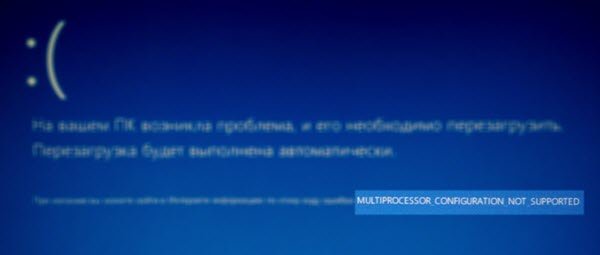If you are running a Windows PC that has different processors clubbed together, then during software installation or Windows Upgrade, the chances are that you may receive a MULTIPROCESSOR CONFIGURATION NOT SUPPORTED error in Windows 11/10.
This bug check has a value of 0x0000003E. This also indicates that the processors are asymmetric in relation to one another. If you wish to upgrade, you need to have all processors of the same type, and level. In this guide, we will help you to resolve this error in Windows 11/10.

MULTIPROCESSOR_CONFIGURATION_NOT_SUPPORTED Blue Screen
This error can occur in various situations. It can be during Windows 11/10 installation, the driver is loaded or during a Windows Start or shutdown and the chances of getting a blue screen is very high. If you see this error, here are a few things you could try.
1] Disable Hyper-Threading in your BIOS
Hyper-Threading lets a processor (multi-threaded) run multiple tasks simultaneously. To disable this, restart your PC, and boot into the PC. You may have to use F2 to do that. Once into the BIOS, look for the option of Hyper-Threading, which should be under Performance along with other options, including Multi-core support, Rapid Start technology, and so on. Once you disable it, make sure to save and exit.
Even though Hyper-threading is used only when it is necessary, some OEMs don’t offer an option to turn it off. If that’s the case, there is not much you can do.
2] Disable Virtualization in your BIOS
Virtualization allows users to run single physical resource like your server or storage device to appear that it is running as multiple logical resources. Also popularly termed as HYPER-V, you need to boot into BIOS and look for Security options. You should be able to find Virtualization Technology or VTX in the options. Turn it off, and reboot your PC.
While Windows 11/10 also offers features like Device Security for Core Isolation and Memory Integrity, turning them off at the software level will not help. Once you can resolve this error, you can further research and see what software or hardware fix can help you further.
3] Check if there are any BIOS updates for your computer
It is always a good idea to update your BIOS. Most of the OEMs offer Utility software that can download BIOS firmware, and update it with less hassle. The updates usually offer enhancements and fixes, which will eventually help the software maintain its compatibility with the hardware and the software.
Let us know if any of these helped to fix the problem.